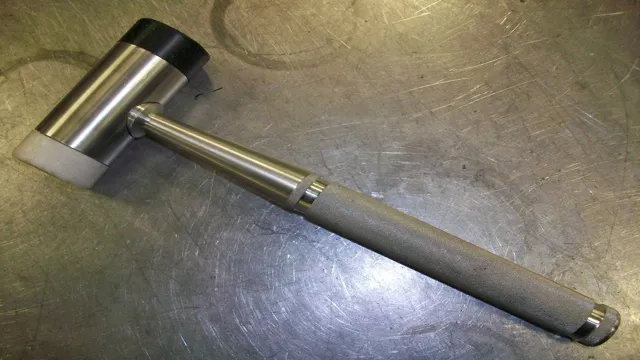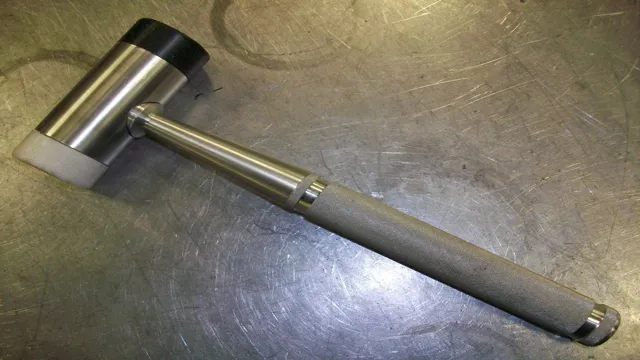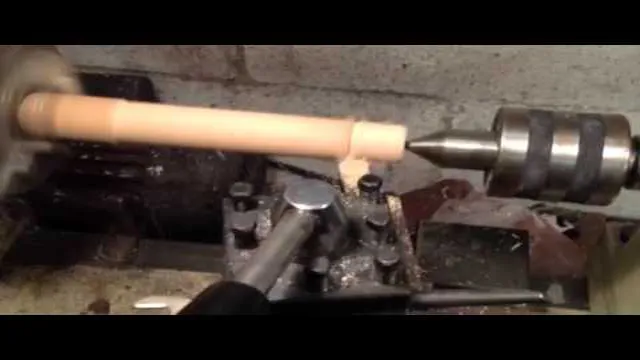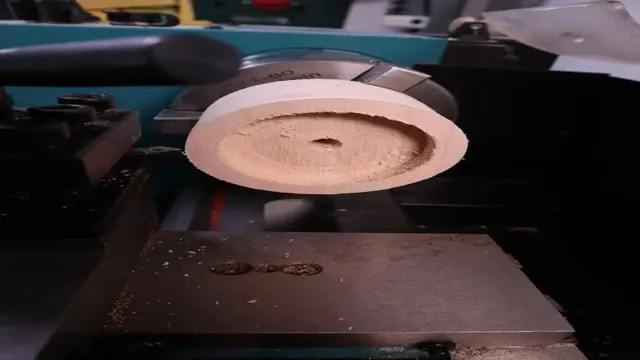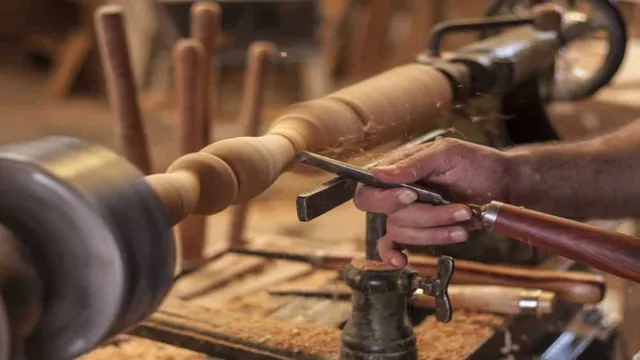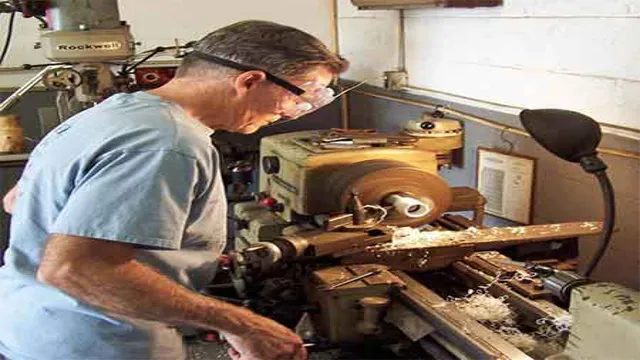How to Sharpen Metal Lathe Tools by Hand: Tips and Techniques
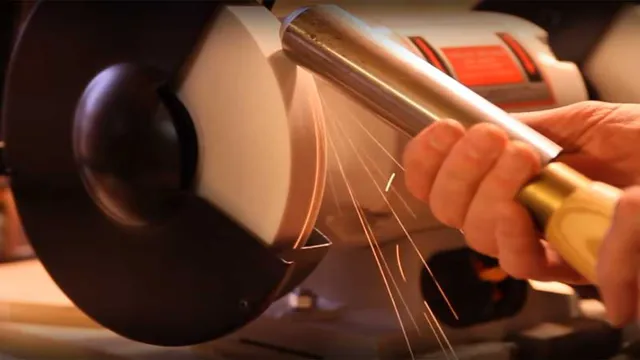
If you’re a machinist or metalworker, you understand the importance of maintaining sharp tools. Dull tools can lead to imprecise cuts, lower quality output, and even damage to your lathe. Sharpening your lathe tools by hand may seem like an intimidating task, but it doesn’t have to be.
With a little practice and patience, you can hone your tools to a razor-sharp edge that will improve the quality of your work and make your job easier. In this blog post, we’ll walk you through the steps to sharpening metal lathe tools by hand, so you can keep your lathe functioning at its best.
What you will need
Sharpening metal lathe tools by hand is a task that can seem daunting at first, but with the right tools and techniques, it can be done easily and effectively. To get started, you’ll want to make sure you have a few things on hand. Firstly, you’ll need a good honing stone or grinding wheel that is specifically meant for sharpening metal lathe tools.
Next, you’ll want to have a sturdy vice or clamp to hold your tools securely in place while you work on them. Additionally, a pair of safety goggles, gloves, and a dust mask can help protect you from any flying debris or dust generated during the sharpening process. Once you have all of your equipment ready, you can dive into the process of sharpening your tools and creating precise and clean cuts.
With a bit of practice and patience, you too can become an expert at sharpening metal lathe tools by hand and take your turning to the next level.
Grinding stone
If you’re looking to sharpen your tools or bring dull blades back to life, you’ll need a reliable grinding stone. To start, you’ll need to find a secure work surface set up with a vice or other tool-holding mechanism – this will provide stability and minimize the risk of injury. Next, select a grinding stone that suits the project you have in mind, as there are various types available for different purposes.
You may need a fine-grit stone for deburring or a coarse-grit stone for removing rust or reshaping metal. It’s important to wear protective gear like goggles and gloves, as small fragments or sparks may fly off during the grinding process. Keep the stone lubricated to avoid overheating and ensure a smooth grind.
With these tools and techniques, you’ll be able to achieve a precise edge and prolong the life of your favorite equipment.
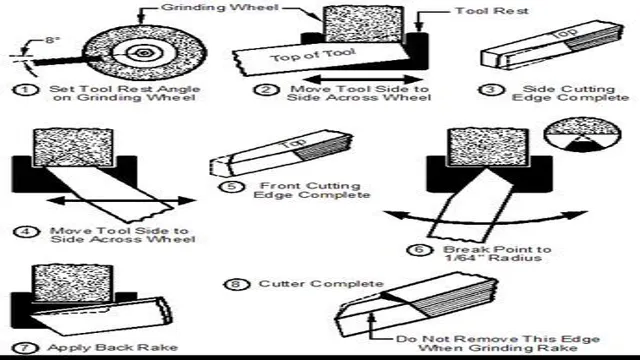
Gloves
When it comes to gloves, there are a few things you will need to consider before making a purchase. First and foremost, you will want to think about what type of activity or task you will be using the gloves for. If you will be working with heavy machinery or tools, you will need gloves that provide ample protection from cuts or impact.
However, if you will be doing delicate work, such as sewing or crafting, you will want gloves that offer a higher level of dexterity. Additionally, you will need to consider the size and fit of the gloves. Gloves that are too small will be uncomfortable and may restrict movement, while gloves that are too big will not provide adequate protection.
Always try on gloves before purchasing to ensure the perfect fit. Another thing to keep in mind is the material of the gloves. Leather gloves are durable and provide excellent protection, while cotton gloves are lightweight and breathable.
Finally, consider the climate in which you will be working. Insulated gloves are ideal for cold weather, while waterproof gloves can come in handy during wet conditions. No matter what type of gloves you choose, be sure to invest in a high-quality pair that will provide you with the protection and comfort you need.
Oil stone
If you’re looking to sharpen your tools or knives, an oil stone can come in handy. These stones are designed to be used with oil to give your blades a razor-sharp edge. But what exactly do you need to get started? First, you’ll need an oil stone itself.
You can find these stones in different sizes and materials, such as natural oil stones or synthetic ones like ceramic or diamond. You’ll also need some honing oil, which helps lubricate the stone and prevent it from clogging with metal shavings. Additionally, it’s a good idea to have a flattening stone or plate to keep your oil stone smooth and level over time.
With these basic tools, you’ll be well on your way to sharpening your blades like a pro.
Safety goggles
When it comes to protecting your eyes, safety goggles are a must-have. Whether you are working on a construction site, in a laboratory, or doing DIY projects at home, safety goggles are essential for keeping your eyes safe from potential hazards. When selecting a pair of safety goggles, look for ones that fit securely and comfortably over your eyes and provide adequate coverage.
You want to make sure they meet the safety standards for the specific task you are performing. The last thing you want is to compromise your vision due to a lack of proper eye protection. Remember, safety should always come first, and safety goggles are an investment in your health and well-being.
Preparing the tool
Sharpening metal lathe tools by hand can be a challenging but rewarding task. To begin the process, it is essential to prepare the tool properly. First, use a wire brush to remove any rust or debris from the cutting edge.
Next, wipe the tool down with oil or a rust preventative to protect it from future corrosion. Additionally, make sure the tool is properly secured in a clamp or vice before beginning the sharpening process. This will prevent the tool from slipping or moving while you work.
Finally, ensure that you have the appropriate sharpening equipment, such as a bench grinder or sharpening stone, to achieve the desired result. Taking the time to properly prepare your tool before sharpening will help ensure a safe and effective sharpening process, resulting in high-quality lathe tools that perform with precision and accuracy.
Clean the tool
Before you start working with your tool, it is important to prepare it properly. One of the essential steps in this process is cleaning the tool. A dirty tool can not only impact the quality of your work but also reduce its lifespan.
To clean the tool, start by removing any excess debris or dirt. You can then use a soft cloth or brush to wipe down the tool and remove any remaining dirt. If the tool has blades or edges, be sure to sharpen them before use.
Additionally, if the tool requires lubrication, apply it accordingly. By taking the time to properly clean and prepare your tool, you can ensure that it is in optimal condition for your next project.
Grind the tool
“Preparing the tool” for woodworking or metalworking requires grinding it to shape and sharpen its edges. Grinding is the process of removing excess metal from the tool’s surface using an abrasive wheel or stone. The tool is clamped to a bench or handheld and fed onto the grinding wheel.
Grinding produces a lot of heat, so it’s essential to cool down the tool frequently by dipping it in water. The angle and shape of the tool must be maintained to ensure that it functions optimally. Therefore, craftsmen frequently utilize jigs to manage the grinding process and guarantee that it’s consistent and accurate.
When grinding, you should take great care not to overheat the tool’s edges, resulting in them losing their hardness. The key to a good grinding job is to go slowly and check your work regularly. With patience and practice, anybody can learn how to grind their tools effectively.
Sharpening the tool
Sharpening metal lathe tools by hand is a skill that every machinist must have. A dull tool not only increases the chance of accidents but also produces subpar work. But fear not, for sharpening tools by hand is a simple process that requires a bit of patience and practice.
First, you must choose the right type of abrasive material, such as a sharpening stone or diamond abrasive pads. Next, secure the tool in a vise or holder, making sure it doesn’t move while sharpening. Then, using a back and forth motion, run the tool across the abrasive material until it has the desired edge.
Remember to keep a consistent angle throughout the process, and always start with a coarse grit and work your way up to a finer grit until the tool is razor-sharp. By spending a little extra time to sharpen your tool properly, you can ensure safer and more precise work outcomes.
Adjust the grinding angle
When it comes to sharpening your tools, one of the most important steps to take is adjusting the grinding angle. This angle determines how much metal is removed from the tool and how sharp the edge will be. The ideal angle will depend on the type of tool you are sharpening and its intended use.
For example, a kitchen knife may have a different angle than a woodworking chisel. To adjust the angle, you’ll need to use a sharpening stone and guide to ensure that the tool is held at the correct angle while you move it back and forth across the stone. It may take some trial and error to find the perfect angle for your tool, but once you do, you’ll notice a significant improvement in its sharpness and effectiveness.
So the next time you’re looking to sharpen your tools, don’t forget to pay attention to the grinding angle – it could make all the difference in the world.
Sharpen with oil stone
Sharpening a tool is a vital part of keeping it in good condition for use. And one of the best ways to sharpen a tool is by using an oil stone. An oil stone is a flat, abrasive stone used for sharpening blades and edges.
To sharpen your tool, you need to first ensure that the oil stone is properly lubricated with oil. This prevents the stone from getting clogged with debris and ensures that the blade slides easily across the stone. Once the stone is ready, you need to place your tool at a 20-degree angle and drag it across the stone in a consistent motion.
Repeat this process several times on each side until the blade is sharp. With this simple technique, you can easily sharpen your tools and keep them in top condition for efficient use. Keyword: Oil stone
Dress the stone for grooves
When it comes to dressing a stone for grooves, sharpening the tool is a crucial step. The first thing to consider is the type of tool needed for the job. A chisel can be a great tool for creating grooves in stone, but it must be sharp enough to do the job effectively.
Sharpening the chisel is the first step in creating sharp grooves on a stone surface. Using a sharpening stone, grind the edge of the chisel at a consistent angle until it’s sharp enough to shave the hair on your arm. It’s also important to remember that a dull tool can cause more harm than good to the stone surface.
So, take your time sharpening the tool and ensure that it’s sharpened correctly before proceeding with the grooving process. By doing so, you’ll be well on your way to creating beautiful grooves on your stone surface that will last a lifetime.
Testing the sharpness
Sharpening metal lathe tools by hand may seem daunting at first, but with a bit of practice it can become a satisfying and precise task. A critical part of this process is testing the sharpness of your tools. One simple test is to run the tool along your thumbnail at a slight angle.
If it doesn’t catch, the edge is likely too dull. Another test is to make a light cut on a piece of scrap metal – the smoother the cut, the sharper the tool. It’s important to remember that different tools will require different sharpening methods and angles, so experimentation is key.
When using a grinding wheel or sharpening stone, it’s also crucial to avoid overheating the metal, which can compromise the tool’s hardness and strength. With a bit of patience and trial-and-error, anyone can learn how to sharpen metal lathe tools by hand and get the precision cuts necessary for their projects.
Visual inspection
When it comes to testing the sharpness of a product, visual inspection is a key step. This involves carefully examining the product to determine if it has any defects or issues that could impact its performance. One way to do this is to use a magnifying glass to look closely at the edges of the product, checking for any signs of dullness or imperfections.
Another important factor to consider is the consistency of the sharpening across the entire product. Even the smallest flaw can have a big impact on the final results, so it’s essential to be thorough in your examination. By taking the time to visually inspect your product, you can ensure that it meets the highest standards of quality and is ready to perform at its best.
So, whether you are sharpening a knife, a pair of scissors or any other tool, be sure to give it a close and careful visual inspection.
Touch or feel the tool
When it comes to using tools, it’s important to test their sharpness before diving into your project. The best way to do this is to touch or feel the tool, running your finger along the blade to see if it’s smooth or if there are any rough spots. If the blade feels rough, it’s likely not very sharp and will need to be sharpened before use.
It’s also important to keep in mind that different types of tools will require different levels of sharpness. For example, a knife used for cooking should be very sharp, while a saw used for cutting wood may not need to be quite as sharp. Testing the sharpness of your tools can not only help you to work more efficiently, but it can also help to prevent accidents and injuries.
So next time you pick up a tool, take a moment to feel its sharpness before getting to work.
Conclusion and Safety Tips
In summary, sharpening metal lathe tools by hand may seem daunting at first, but with the right technique and a little bit of practice, anyone can achieve razor-sharp precision in their cuts. Think of it as a sculpting exercise for your metalworking skills, honing your abilities and creating masterpieces with each pass of the blade. So grab your sharpening stone and get ready to put your skills to the test, because with these tips, you’ll be turning heads (and metal) in no time.
“
FAQs
What are the basic steps for sharpening metal lathe tools by hand?
The basic steps for sharpening metal lathe tools by hand involve cleaning the tools, setting the correct angle, grinding the edges, honing the tools, and finally, testing and adjusting the sharpness.
What tools do I need to sharpen metal lathe tools by hand?
You will need a bench grinder, a honing stone or diamond sharpening plate, a protective face shield, a pair of gloves, and a tool rest or jig to help maintain the correct angle.
How do I know when my metal lathe tools need sharpening?
You can tell when your metal lathe tools need sharpening if they start to produce rough or uneven cuts, leave burn marks on the material, or create excessive noise or vibration.
Can I sharpen metal lathe tools without a grinder?
Yes, you can sharpen metal lathe tools without a grinder by using a sharpening stone or diamond plate to hone the edges. However, a grinder is typically faster and more efficient for heavy-duty sharpening.
What is the optimal angle for sharpening metal lathe tools?
The optimal angle for sharpening metal lathe tools depends on the specific tool and its intended use. Generally, angles between 35 and 45 degrees are a good starting point.
How often should I sharpen my metal lathe tools?
The frequency of sharpening your metal lathe tools will depend on how often you use them and the type of material you are working with. As a rule of thumb, it’s a good idea to inspect and sharpen your tools every few months.
Are there any safety precautions I should take when sharpening metal lathe tools by hand?
Yes, you should wear eye protection, a face shield, and gloves to prevent injury from flying debris or sparks. You should also ensure that the tool is securely mounted and that you maintain a safe distance from the grinding wheel.

